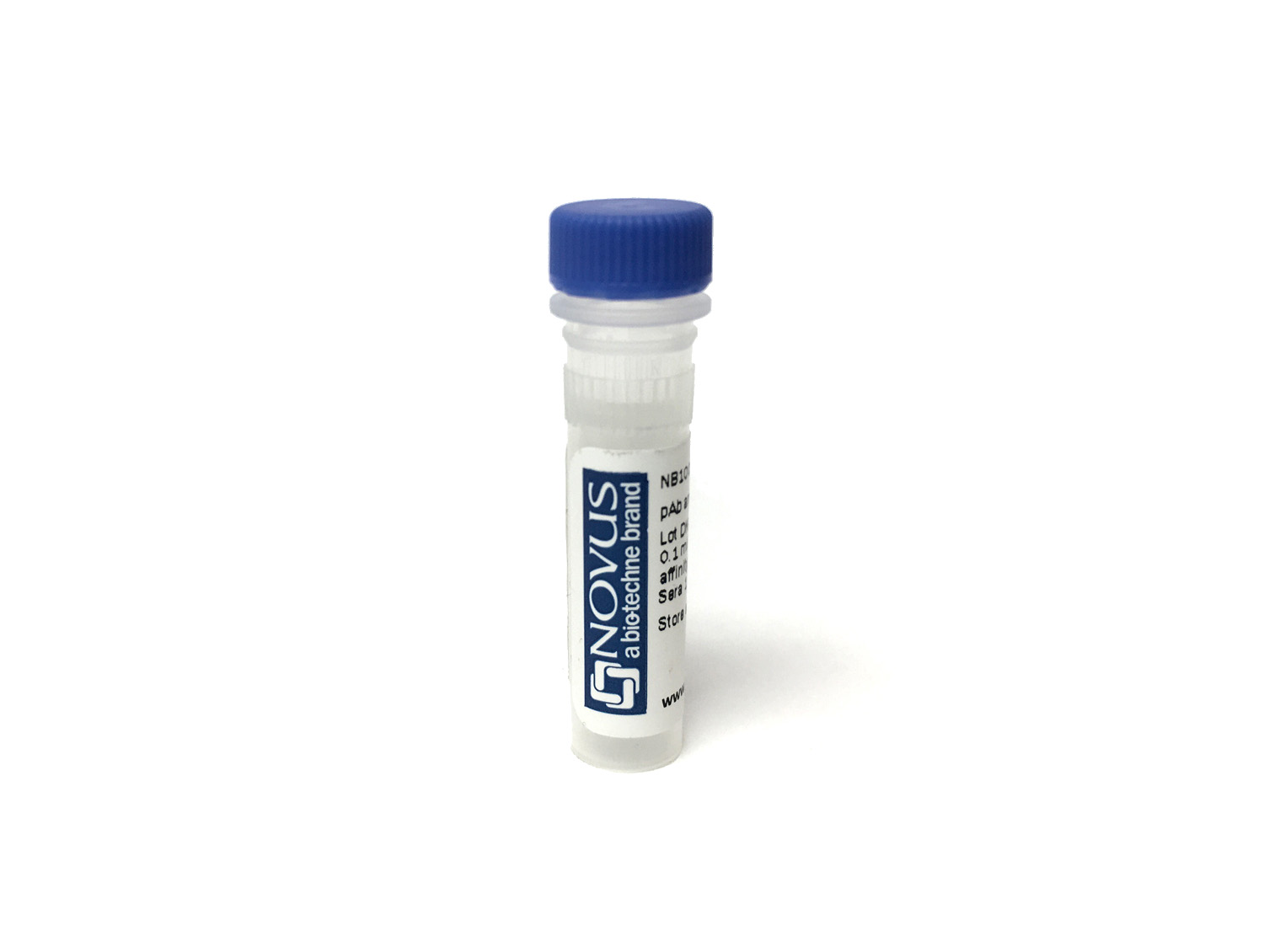Fas/TNFRSF6/CD95 Antibody (rB-R18) - Azide and BSA Free
Novus Biologicals, part of Bio-Techne | Catalog # NBP3-20704
Recombinant Monoclonal Antibody


Conjugate
Catalog #
Key Product Details
Species Reactivity
Human
Applications
Flow Cytometry, Immunocytochemistry/ Immunofluorescence, Immunohistochemistry-Frozen
Label
Unconjugated
Antibody Source
Recombinant Monoclonal Mouse IgG2a Kappa Clone # rB-R18
Format
Azide and BSA Free
Concentration
1 mg/ml
Product Specifications
Immunogen
Recombinant human Fas/TNFRSF6/CD95 protein
Localization
Cell surface.
Specificity
monoclonal antibody rB-R18 specifically recognizes Fas/TNFRSF6/CD95, also known as Fas, a transmembrane glycoprotein with a MW of 40-45kDa, containing 8kDa of N-glycoside-linked polysaccharide
Clonality
Monoclonal
Host
Mouse
Isotype
IgG2a Kappa
Description
Positive Controls: MCF-7 cells (IF/FACS). Human hepatocellular or bladder carcinoma (IHC).
Antibody with azide - store at 2 to 8C. Antibody without azide - store at -20 to -80C. Non-hazardous. No MSDS required.
Antibody with azide - store at 2 to 8C. Antibody without azide - store at -20 to -80C. Non-hazardous. No MSDS required.
Applications for Fas/TNFRSF6/CD95 Antibody (rB-R18) - Azide and BSA Free
Application
Recommended Usage
Flow Cytometry
1-2 ug/million cells
Immunocytochemistry/ Immunofluorescence
1-2 ug/ml
Immunohistochemistry-Frozen
0.5-1 ug/ml
Application Notes
Immunohistochemistry (Frozen): 0.5-1ug/ml for 30 minutes. at RT.
Optimal dilution for a specific application should be determined.
Optimal dilution for a specific application should be determined.
Formulation, Preparation, and Storage
Purification
Protein A or G purified
Formulation
10mM PBS
Format
Azide and BSA Free
Preservative
No Preservative
Concentration
1 mg/ml
Shipping
The product is shipped with polar packs. Upon receipt, store it immediately at the temperature recommended below.
Stability & Storage
Store at -20 to -70C. Avoid freeze-thaw cycles.
Background: Fas/TNFRSF6/CD95
Fas-FasL-mediated apoptosis is important in immune homeostasis and removal of autoreactive T cells, autoreactive B cells, cytotoxic natural killer (NK) cells, and more (1,2,7). Dysfunction and mutations in the Fas receptor and the Fas-FasL signaling axis is associated a loss of apoptotic signaling and removal of autoreactive cells, which correlates with several autoimmune diseases including systemic lupus erythematosus (SLE), autoimmune lymphoproliferative syndrome (ALPS), and multiple sclerosis (MS) (1-4,6,7). In addition to apoptosis and cell death signaling, FasL/TNFRSF6/CD95 mediates other pathways involved in proliferation, survival, and differentiation (3,4,6,8). More specifically, Fas has been shown to activate the NF-kappaB pathway, driving innate immunity which includes IL-1beta production and functioning in host defense (3,4,6,8). Fas is also involved in adaptive immunity playing a role in co-stimulation of CD4+ and CD8+ T cell activation as well as precocious differentiation of naive cells to effector memory T cells (3,4,6). Differentiation into effector memory T cells shows protection against autoimmunity but also limits antitumor response to a form of cancer immunotherapy called adoptive cell transfer (ACT) (3,4). The non-apoptotic roles of the Fas/TNFRSF6/CD95 receptor highlight its potential as a target for both treating autoimmune diseases and in cancer immunotherapy (3,4).
References
1. Singh R, Pradhan V, Patwardhan M, Ghosh K. APO-1/Fas gene: Structural and functional characteristics in systemic lupus erythematosus and other autoimmune diseases. Indian J Hum Genet. 2009;15(3):98-102. https://doi.org/10.4103/0971-6866.60184
2. Magerus A, Bercher-Brayer C, Rieux-Laucat F. The genetic landscape of the FAS pathway deficiencies. Biomed J. 2021;44(4):388-399. https://doi.org/1010.1016/j.bj.2021.06.005
3. Guegan JP, Legembre P. Nonapoptotic functions of Fas/CD95 in the immune response. FEBS J. 2018;285(5):809-827. https://doi.org/10.1111/febs.14292
4. Yi F, Frazzette N, Cruz AC, Klebanoff CA, Siegel RM. Beyond Cell Death: New Functions for TNF Family Cytokines in Autoimmunity and Tumor Immunotherapy. Trends Mol Med. 2018;24(7):642-653. https://doi.org/10.1016/j.molmed.2018.05.004
5. Uniprot (P25445)
6. Guegan JP, Ginestier C, Charafe-Jauffret E, et al. CD95/Fas and metastatic disease: What does not kill you makes you stronger. Semin Cancer Biol. 2020;60:121-131. https://doi.org/10.1016/j.semcancer.2019.06.004
7. Volpe E, Sambucci M, Battistini L, Borsellino G. Fas-Fas Ligand: Checkpoint of T Cell Functions in Multiple Sclerosis. Front Immunol. 2016;7:382. Published 2016 Sep 27. https://doi.org/10.3389/fimmu.2016.00382
8. Cullen SP, Martin SJ. Fas and TRAIL 'death receptors' as initiators of inflammation: Implications for cancer. Semin Cell Dev Biol. 2015;39:26-34. https://doi.org/10.1016/j.semcdb.2015.01.012
Long Name
Fibroblast-associated
Alternate Names
Apo-1, APT1, CD95, TNFRSF6
Gene Symbol
FAS
Additional Fas/TNFRSF6/CD95 Products
Product Documents for Fas/TNFRSF6/CD95 Antibody (rB-R18) - Azide and BSA Free
Product Specific Notices for Fas/TNFRSF6/CD95 Antibody (rB-R18) - Azide and BSA Free
This product is for research use only and is not approved for use in humans or in clinical diagnosis. Primary Antibodies are guaranteed for 1 year from date of receipt.
